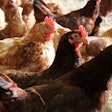
Palatability has become as important to petfood formulation as the core ingredients. After all, those ingredients can’t provide nutritional benefits if pets won’t eat the food or, perhaps more importantly, their owners don’t perceive the pets are enjoying the food. Thus, leading companies invest heavily in research and work to ensure they can accurately measure the palatability of their flavor enhancers.
Panelis: avoiding bias in palatability testing
For palatability testing panels, the control and stability of environmental parameters and the accuracy of protocols are key elements to achieving consistent palatability results. But even with the best management of these elements and even in expert facilities, some biases can occur when working with animal panels. These biases can significantly distort the interpretation of test results. “One of the responsibilities of our measurement experts and animal behaviorists is to continuously improve the protocols in order to eliminate bias as much as possible,” says Christelle Tobie, communications manager for Panelis.
How do you explain that the same test repeated on two different panels can sometimes deliver different results? In 2004, Panelis pointed out that strong food habits play an important role in the animals’ choice (Larose, 2004). Ensuring a diversity of foods was proposed as a relevant solution.
The dietary past and development of food habits in animals can often explain the discrepancies between panels. Moreover, the methodologies are not always exactly the same, which contributes to the panel effect. To avoid these effects, it is necessary to standardize testing panels; therefore, Panelis diversifies kibbles and products fed to the animals as much as possible.
Standardization also means a randomized choice of several panels are selected for each test. To further eliminate bias, Panelis implements palatability evaluation with subgroups of animals from different testing centers. The panel is then made up of animals not necessarily having the same feeding past or food habits. This virtual panel can be set up at a subgroup level or at an individual level. This solution also has the advantage of not physically moving animals, which could create additional disturbances.
Still other types of biases can arise. For example, to help avoid position eater tendencies, Panelis has implemented an index of lateralization to control this bias in versus tests. The index of lateralization is calculated every three months. It considers the frequency of meals during which significantly higher intake is observed on one side. This methodology aims at removing animals that are considered strongly critical: animals having an index over 70% on two consecutive quarters. This protocol identifies the true position eaters, meaning ones exerting a preference for one side regardless of the product or conditions.
The link between bias controls and reliability of results is acknowledged and addressed. Being able to control bias allows the introduction of new measurement tools or a combination of different methods to ensure consistency of test results. “The development of expertise in the field of palatability measurement is inherent to the continuous improvement of methodologies,” Tobie says. “That’s the everyday purpose at Panelis.”
Kemin: in-home petfood palatability testing
The only way to tell if pets like their food is to ask them, points out Sara Cutler, PhD, R&D manager of the functional ingredient and supplement group for Kemin Nutrisurance. But how do you go about getting their opinion? Cats like to eat when they want to eat and are unlikely to give their first choice between diets without special equipment or owners’ standing vigil by their bowls. Many dogs are willing to give any input into food (Kibble? My favorite!), but are they eating what is most appetizing to them? What about the influence of kibble size, shape and the breed of the test animal on food preference?
In the quest for ever higher palatability in petfood, new palatability enhancers will go through the obligatory two-pan test comparing diets A and B and applying statistical analysis to show a win, lose or parity. Kennel testing of diets is the standard method to test palatability. Panels of dogs and cats are presented with two options, each with a different palatant formulation but with presumably the same diet formula as a control factor. These animals have a career making a decision for petfood companies regarding what the next best flavor may be.
With the two-pan test, Diet A is presented on the right side and B on the left, and the test is stopped when all of one diet is consumed or half of each is eaten. How this test is performed for dogs vs. cats is slightly different. For dogs, they may be meal fed in this manner with A and B alternating sides for the next day or a second feeding if fed twice/daily. Dogs are fed one at a time to minimize competition.
For cats, the situation is different, as they are not typically meal fed. The diet choices are left to be nibbled on for 16-24 hours. Colonies of cats may also be left to graze as they please.
In a pet owner’s house, rarely does anyone compare one diet’s palatability to another side by side. Most often, diets are replaced after a period, and the new diet is either liked or disliked after first exposure. Or after a diet is fed for a period, it is rejected.
To consider both the impact of the purchaser and the consumer on the petfood diet, in-home preference testing has been used. To an ingredient supplier such as Kemin, this type of testing gives an option to the traditional “send the diet out to a kennel and wait” approach and offers additional information to the petfood palatant selection process:
- The two-pan test performed in front of the customer offers the pet’s owner a perspective on the likeability of the diet. A lack of enthusiasm or an over-excited celebration at the diet’s smell or taste gives the owner a good feeling and results in positive feedback to the formulator;
- From a population perspective, the in-home test panel offers a broader look at breeds and preferences. For example, the Kemin panel has toy to giant dog breeds; and
- Opinions given by professional taste-testing animals in a kennel may be different than those given by pets in your home. Animals in a kennel situation that are exposed to many different diets may indeed have a more refined palate than the dog that has eaten the same diet for years.
However, there are drawbacks to the in-home method of testing. One concern may be the difficulty in training the participants. It is true that sending a diet to a kennel to test is an easier option than training a large group of people, as well as their animals, to perform a standardized test. Training may need to occur multiple times to remind owners about feeding guidelines (meal vs. free access feeding), retrain the animals to not gobble the first diet they have access to and overcome “handedness,” or the tendency to gravitate to one bowl without deciding which diet they like better.
In this case cats are an easier option as taste panel participants. Cats may be more difficult to enroll in the program, however, due to the tendency to have more than one cat per household. It is nearly impossible to know which cat is eating which diet if one is larger and dominates the consumption ratio.
There are other concerns with maintaining an in-home test panel:
- Maintaining the health status of the animals involved, which means yearly veterinary physicals to make sure the animal stay healthy enough to participate;
- Ensuring the animals do not have food allergies or eat a special diet, which would interfere with their ability to test a variety of petfood formulations; and
- Relaying the importance to owners of this testing to reduce the amount of snacks given outside of mealtime.
Of course, the biggest concern to the R&D department in charge of creating that new palatability enhancer formula would be if the data generated correlates to that of kennel testing. The individual variation between animals and diet consumed prior to the in-home trial certainly adds to statistical complexity, but in the end, at least with the Kemin Nutrisurance program, it has generated similar results to identical tests sent to commercial kennels, Cutler says.
The consumer data is an aspect of the in-home testing program that cannot be underestimated, and how that data is captured is important. During the course of a two- or four-day test, pet owners must be motivated to record many observations about the meals provided to their pets. While many pet owners appreciate the free food, there can be drawbacks to frequent diet switches, particularly when the dog or cat overconsumes and vomits. Kemin offers an incentive program for owners for their time and trouble and for such “reversal of fortune” incidents.
When developing new flavors, the consumer aspects of petfood come into play, and never is this more evident than when testing palatability with in-home tests. Though it can be difficult to initiate and standardize, in-home petfood testing provides insight into the pet feeding experience and can offer valuable insights into what pet owners and their furry family members prefer, according to Kemin.
AFB’s PARC facility: a home for the latest in palatability study
No matter the formulation, manufacturing or marketing efforts, the success or failure of a petfood product depends on acceptance by the dogs and cats for which it was designed. Recognizing that, the industry has—since the mid-1980s—invested in and relied heavily on palatability studies, which scientifically evaluate and analyze the desirability of certain petfoods.
A recent evolution in palatability research deals with an often overlooked variable in conducting studies. Conventional studies tend to focus on what and when; AFB International is taking a new approach to where.
AFB opened the 25,000 square-foot Palatability Assessment Resource Center (PARC) in 2007. This innovative facility provides an open living environment for the companion animals that reside there. The mission of PARC is to maintain a caring, homelike environment for the animals while providing the structure necessary to support leading palatability research.
Today’s companion animals are treated as members of the family. Their lives are structured around the family schedule. The dogs and cats living with the AFB family at PARC experience this same home structure. The animals enjoy a daily routine that includes ongoing socialization, obedience training, individual and group play, grooming and regular meals and treats.
“At PARC we’re another step closer to replicating the physical and emotional stability of a natural environment,” says Amy McCarthy, PhD, AFB’s senior science manager of palatability. “In this living situation, each animal’s personality comes out because it depicts a normal social environment for the dogs. When their personality is more visible, you can more easily see their enthusiasm for the flavors of the food.”
AFB believes providing this environment is not only the right way to treat the companion animal, it is the best way to predict product performance. “The data we collect are only as good as our test subjects,” says McCarthy. “Our feeding studies are incorporated into the companion animals’ established schedule. So our studies better replicate the experiences of our customer’s end-user. We believe this living environment leads to feeding behavior that is more reflective of the typical companion animal population.”
Petfood marketers want to know how well a product will perform in the real world. PARC provides an environment that simulates real world on a small but projectable scale. It also provides information to better understand that real world.
Product acceptance by the companion animal goes beyond product consumption. With a strong focus on animal physiology, AFB studies the effects of palatants on the dietary preferences of dogs and cats.
Within the environment of PARC, the staff identify any behavioral changes, particularly around each feeding, that occur during the trial. These observations, provided to researchers on every feeding, provide valuable insights to everyone on the R&D teams. Along with quantitative data, the staff at PARC is encouraged to add anecdotal comments to their reports. Comments such as “Champion ate right away” or “All the dogs ate slowly” can help researchers understand the product’s total performance in the context of the animals’ eating behaviors.
Human observation at AFB’s PARC is supported by the latest in monitoring science—for example, using patented RFID technology in studying palatability with cats. With RFID, AFB researchers know not only the quantity of food consumed by individual cats, they also know how many individual visits each cat made to the feeding bowl, how much was eaten at each feeding and the pace at which the cat ate. They are better able to see the food selection habits of the cat, from the first taste generated by aroma through the last bites that reflect the cat’s total eating experience. This data helps further qualify the consumption portion of the study and build an overall understanding of eating patterns.
AFB is also using this science in studies of flavor novelty and how it influences the feeding trials. Knowing what is eaten because it is new vs. what is eaten because it is better further helps in developing long-term palatability solutions.
For more information on PARC and AFB, call +1.800.218.5607.















